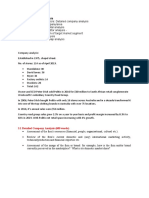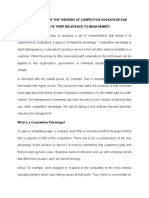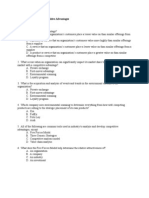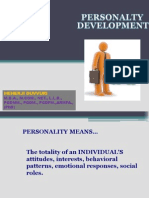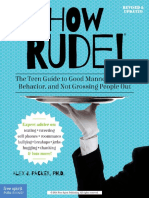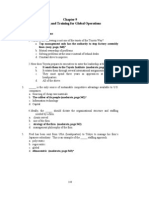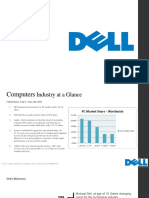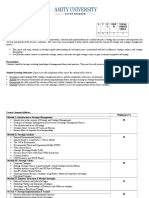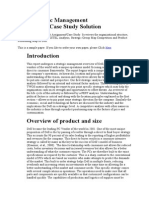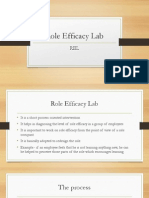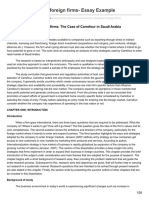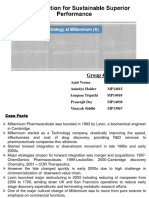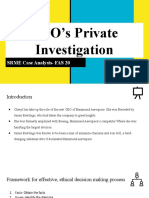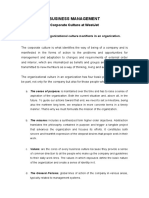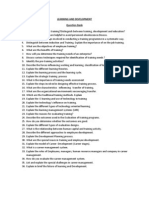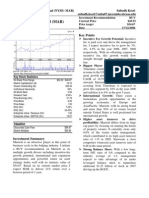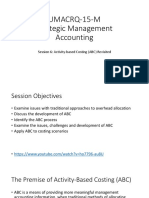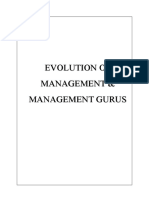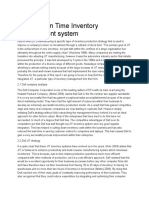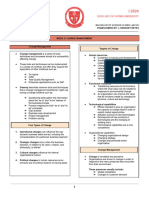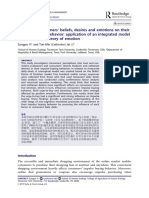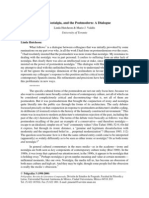0 ratings0% found this document useful (0 votes)
128 viewsMCQ'S: 7. Which One Is The Final Step in The Decision-Making Process
This document contains 54 multiple choice questions related to organizational culture, leadership, decision making, communication, and other management topics. The questions cover concepts like dimensions of organizational culture, types of regional trade alliances, steps in the decision making process, assumptions of rational decision making, benefits of strategic management, and characteristics of teams. The questions are designed to test knowledge of fundamental management principles and theories.
Uploaded by
Amna KanwalCopyright
© © All Rights Reserved
Available Formats
Download as DOCX, PDF, TXT or read online on Scribd
0 ratings0% found this document useful (0 votes)
128 viewsMCQ'S: 7. Which One Is The Final Step in The Decision-Making Process
This document contains 54 multiple choice questions related to organizational culture, leadership, decision making, communication, and other management topics. The questions cover concepts like dimensions of organizational culture, types of regional trade alliances, steps in the decision making process, assumptions of rational decision making, benefits of strategic management, and characteristics of teams. The questions are designed to test knowledge of fundamental management principles and theories.
Uploaded by
Amna KanwalCopyright
© © All Rights Reserved
Available Formats
Download as DOCX, PDF, TXT or read online on Scribd
You are on page 1/ 14
MCQ’s
1. The culture of an organization is largely determined by:
► Top management
► Employees
► Stockholders
► The company founders
2. Sony Corporation’s focus on product innovation is an example of which of the following
dimensions of organizational culture?
► Attention to detail
► People orientation
► Outcome orientation
► Aggressiveness
3. An individual’s personal beliefs regarding what is right and wrong or good and bad is
called:
► Ethics
► Values
► Norms
► Rituals
4. EU, NAFTA, FTAA and ASEAN are examples of:
► Regional trade alliances
► Foreign airlines
► Soccer teams in Europe
► New multinational corporations
5. "Whenever possible, we promote from within" is an example of which of the following?
► Rule
► Procedure
► Policy
► Plan
6. What was the focus of leadership studies in 1920s and 1930s?
► Charisma
► Tasks
► Traits
► Behavior
7. Which one is the final step in the decision-making process:
► Evaluating the decision
► Recognizing the decision
► Evaluating the alternatives
► Implementing the decision
8. All of the following are the assumptions of rational decision making EXCEPT:
► Alternatives are known
► Possible outcomes known
► Optimal decision is possible
► Information is unknown
9. Which of the following is a variation of the electronic meeting that links media from
different locations?
► E-commerce
► The Delphi technique
► E-Brainstorming
► Video conference
10. Operational plans are normally associated with which of the following organizational
level?
► Global level
► Corporate level
► Business level
► Functional level
11. Which of the following is a primary benefit of MBO?
► Avoid competition
► Resistance against new entrance
► Improve employee motivation
► Increase resources
12. In BCG matrix which of the following businesses have a large share of a market that
are not expected to grow substantially?
► Dogs
► Question mark
► Star
► Cash cow
13. Which of the following organization is responsible for the development of small business
in Pakistan?
► SMEDA
► BISE
► ICMA
► PCSIR
14. Employees with more training and experience are able to work with less direct
supervision which is the characteristics of which of the following?
► Wide span of control and a flatter organization
► Violates Fayol’s principle of chain of command
► A highly centralized organization
► Very narrow span of control and more levels of managers
15. Maslow's hierarchy of needs theory proposes that every person has a hierarchy of:
► Four needs
► Five needs
► Three needs
► Six needs
16. Which of the following theory points out that the individual has to be rewarded with
something that he or she values?
► Herzberg’s theory
► Expectancy theory
► Equity theory
► McClelland’s goal setting theory
17. Which of the following is a major drawback of written communication?
► Lack of feedback
► Lack of precision
► Less well thought out
► Lack of verifiable permanent record
18. Which of the following is a primary benefit of MBO?
► Avoid competition
► Resistance against new entrance
► Improve employee motivation
► Increase resources
19. Which of the following is the benefit of strategic management for the organizations?
► Direction for organization
► Competitive advantage
► Supports innovation
► All of the given options
20. The process in which a sender manipulates information so the receiver will see it
more favorably, is called:
► Filtering
► Selective perception
► Noise
► Information overload
21. Control that prevents anticipated problems is called:
► Feed forward control
► Concurrent control
► Feedback control
► Management control
22. Which one of Fayol’s 14 principles of management helps preserve the concept of a
continuous line of authority?
► Unity of demand
► Unity of command
► Demand structure
► Continuous demand
23. A significant edge over the competition in dealing with competitive forces is called:
► Core Competencies
► Competitive advantage
► Competitive force
► Swot analysis
24. Which of the following is the benefit of strategic management for the organizations?
► Direction for organization
► Competitive advantage
► Supports innovation
► All of the given options
25. If the environment is stable then the structure of the organization could be:
► Organic
► Divisional
► Mechanistic
► Simple
26. Tendency of people to expend less effort while working in a group as compare to
working alone is called:
► Synergy
► Social Loafing
► Group Task
► Group Cohesiveness
27. Communication which takes place without regard to hierarchical or task
requirements is called:
► Formal
► Informal
► Official
► Ceremonial
28. Cognitive ability of an individual effects the decision making process in which of the
following manner?
► Can not utilize the available resources
► Can not interpret all available information
► Can not provide required financial resources
► Can not control the external situations
29. SWOT analysis is a technique of:
► Environmental scanning
► Forecasting
► Benchmarking
► Budgeting
30. Group members usually do not see each other while making decisions in:
► Brainstorming
► Delphi
► Nominal
► Interacting
31. Which of the following behaviour had dramatically influenced by Hawthorne studies?
► Informal behaviour
► Social behaviour
► Moral behaviour
► Ethical behavior
32. If the environment is stable then the structure of the organization could be:
► Organic
► Divisional
► Mechanistic
► Simple
33. SWOT analysis is a technique of:
► Environmental scanning
► Forecasting
► Benchmarking
► Budgeting
34. Which of the following is called an input to an organizational system?
► Employees
► Products
► Services
► Customers
35. Which of the following techniques relies on individual or group judgments rather
than on mathematical analysis?
► Quantitative forecasting
► Technological forecasting
► Qualitative forecasting
► Benchmark forecasting
36. Considering the changing patterns of the business world, which of the given is considered
to be the modern motivating tool?
► High salary
► Flexi time
► Secured job
► Medical allowance
37. In order to make organization more flexible and responsive through employee
participation, organization should tend towards which of the following?
► Decentralization
► Globalization
► Departmentalization
► Widen the span of control
38. Which of the following is an extrinsic factor of motivation?
► Wages and salaries
► Job variety
► Sense of accomplishment
► All of the given options
39. Starbuck’s of opening one hundred stores per year helps everyone in the
firm, in recognizing the strong emphasis on growth.
► Goal
► Mission
► Vision
► Plan
40. Call centers have been developed to record and put forward the customers’
complaints to:
► Problem solving teams
► Cross functional teams
► Quality circles
► Work teams
41. Pamphlets used for the promotion of a product are the example of:
► Oral communication
► Non-verbal communication
► Written communication
► None of the given options
42. Viewpoint arguing that appropriate managerial action depends on the particular
parameters of the situation is called:
► Contingency theory
► Behavioral theory
► Administrative theory
► Social theory
43. Which of the following is NOT a formal group?
► Command groups
► Task forces
► Cross-functional teams
► Business unit alliances
44. In recent research on trait theory all of the following were indicators of leadership
EXCEPT:
► Extraversion
► Introversion
► Honesty
► Desire to lead
45. Who developed the first comprehensive contingency model for leadership?
► Fiedler
► Vroom
► House
► Hersey
46. Which of the following is a power that has been legitimated by the organizations?
► Responsibility
► Span of control
► Authority
► Accountability
47. The individuals who are working in the organizations in a capacity of generating &
supporting new ideas for the organization are called:
► Lender
► Entrepreneur
► Stakeholder
► Financer
48. SWOT analysis divides organizational strengths into two categories; common
strength and .
► Chance of growth
► Core competency
► System loophole
► Competitor risk
49. All of following are true regarding teams EXCEPT:
► Teams are more flexible than traditional departments
► Teams are less responsive to a changing environment
► Teams can serve as a source of job satisfaction
► Teams better utilize employee talents
50. If you get more output from a given input, you have:
► Decreased effectiveness
► Increased effectiveness
► Decreased efficiency
► Increased efficiency
51. Constituencies in an organization’s external environment that are affected by the
organization’s
decisions and actions are called:
► Stakeholders
► Advisories
► Beneficiaries
► Environmentalists
52. European Union was established in:
► February 1992
► January 1994
► July 1992
► November 1993
53. Operational plans are normally associated with which of the following organizational
level?
► Global level
► Corporate level
► Business level
► Functional level
54. Which of the following is the set of strategic alternatives that an organization chooses
from, as it conducts business in a particular industry or market?
► Business-level strategy
► Corporate-level strategy
► Functional-level strategy
► Market-level strategy
55. In BCG matrix which of the following businesses have a very small share of a market and
are not expected to grow?
► Star
► Dogs
► Cash cow
► Question mark
56. When managers delegate authority, they must allocate equal:
► Responsibility
► Power
► Money
► Influence
57. Which of the following organization is responsible for the development of small business
in Pakistan?
► SMEDA
► BISE
► ICMA
► PCSIR
58. Which of the following creates the “Dual Chain of Command?”
► Team based and Project Structure
► Functional and Simple structure
► Project and matrix Structure
► Simple and matrix Structure
59. Which of the following is an internal state that makes certain outcomes appear attractive?
► Fad
► Desire
► Need
► Fashion
60. The statement that people will exercise self direction and self control if they are
committed to the objectives, is true about which of the following?
► Equity Theory
► ERG Theory
► Theory X
► Theory Y
61. According to Herzberg's Motivation-Hygiene Theory, which of the following is NOT a
hygiene factor?
► Working Conditions
► Salary
► Relationship with supervisor
► Work itself
62. Which of the following group engages in collective work that requires joint effort and
generates a positive synergy?
► Work group
► Work team
► Quality circle
► Functional team
63. Decisions which deal with situations where the factors are fairly structured and occur
with some frequency are called:
► Heuristic decision
► Programmed decision
► Satisfying decision
► Non-programmed decision
64. "Employees dislike work, they are lazy, dislike responsibilities and must be coerced to
perform". Which of the following best describes this statement?
► Hygiene Factor Theory
► Resistance Theory
► Theory X
► Two factors Theory
65. “How long effort is maintained” relates to which of the following approach of performing
a task?
► Intensity
► Direction
► Persistence
► Motivation
66. All of the following are the behavioural theories EXCEPT:
► Path Goal studies
► Ohio State Studies
► Michigan Studies
► Iowa Studies
67. Which of the following can be used as a medium of communication in the organizations?
► Manuals
► Meetings
► Face to face discussions
► All of the given options
68. The force that results in greater combined gains/benefits through group interaction is
called:
► Positive synergy
► Negative synergy
► Individualism
► Cohesiveness
69. Which of the given option represents the relationship between ‘Management Science’ &
‘Operation Management’?
► Both are used interchangeably
► Operation management is an applied form of management science
► Management science is an applied form of operation management
► No relationship exists between the two
70. Job activities performed by workers of an organization are served as:
► Input in a system
► Transformation process
► Output offered by organization
► Feedback from the environment
71. Which of the following is the crucial element of team structure?
► Employee empowerment
► Faster decision-making
► Inexpensive to maintain
► Clear chain of command
72. An unsatisfied need creates which type of emotion?
► Anxiety
► Tension
► Drive
► Pressure
73. People who want to exert more power often engage in which of the following activities?
► Visionary leadership
► Reward power
► Office politics
► Charismatic training
74. A specific group of accountants at an accounting firm that meets regularly to develop
better auditing procedures for the firm can be referred as which of the following?
► Task force
► Functional team
► Cross-functional team
► Virtual team
75. It is most appropriate to use oral communication when you have to communicate:
► A monthly report to the CEO on company performance
► An impersonal message to a group of people
► A lengthy welcoming message to a new salesperson
► A brief, time sensitive personal massage
76. Which of the following is a process that involves managers from all parts of the
organization in the formulation of strategic goals?
► Strategic organizing
► Strategic management
► Strategic positioning
► Strategic planning
77. Which of the following is the obligation or expectation to perform a duty?
► Responsibility
► Unity of command
► Chain of command
► Span of control
78. Which one of Fayol’s 14 principles of management helps preserve the concept of a
continuous line of authority?
► Unity of demand
► Unity of command
► Demand structure
► Continuous demand
79. Mr. Kamran is a manager at virtual university of Pakistan. His responsibilities include
developing a organization-wide marketing strategy that plays on the synergies between
institute’s offered Programs in order to drive increased no. of students. Kamran is a:
► Middle manager
► First-line manager
► Top manager
► Non-managerial
80. Which of the following was created by the unification of 12 countries in Europe?
► European Common Market
► European Union
► Western European Alliance
► Trans-European Market
81. Motivation is the result of interaction between which of the following?
► Efforts and situation
► Employee and manager
► Efforts and intention
► Individual and situation
82. Which of the following are the hygiene factors
► Fringe benefits, recognition and motivation
► Achievement, responsibility and growth
► Friendship groups, working conditions and responsibilities
► Company policies, working conditions and salary
83. Which of the following is an example of body language?
► Eye contact
► Style of dress
► Facial expressions
► All of the given options
84. What is the basic assumption of situational approaches to leadership?
► Increasing worker job satisfaction through consideration behavior will get leaders the
best
results
► Initiating structure for employees by telling them what to do and how to do.
► The appropriate leadership style varies from one set of circumstances to another
► Effective leaders possess certain traits that are situation specific
85. Which of the following statement is NOT true for productivity?
► Productivity is a major goal in virtually every organization
► For individual companies, increased productivity means a more competitive cost
structure
► Productivity is a composite of people and operations variables
► Productivity can be improved by dealing with large number of suppliers
86. All of the following are primary management functions EXCEPT:
► Setting goals
► Hiring employees
► Monitoring activities
► Motivating employees
87. Which one of the following is explaining the Entrepreneur in the best way?
► Goals Setter
► Decision Maker
► Communicator
► Initiator
88. The success of the business can be judged through:
► Customer satisfaction
► Achieving of Organizational Goals
► Cost price reduction
► All of the given options
89. Which level of management is responsible for making organization wide decisions and
establishing the plans and goals that affect the entire organization?
► Non managerial staff
► Top management
► Middle management
► First-line management
90. Henry Fayol described principles of management in the form of:
► 11 points
► 12 points
► 14 points
► 15 points
91. When management provides orderly personnel planning and ensures that replacements
are available to fill vacancies, it is called :
► Division of work
► Discipline
► Unity of command
► Stability of tenure of personnel
92. The father of industrial psychology is:
► Robert Owen
► Hugo Munsterberg
► Mary parker Follett
► Max Weber
93. Environment reacts to the output of organization and provides:
► Feed forward
► Input
► Output
► Feedback
94. Which of the following styles of decision making is characterized by individuals who
prefer complete information and consider several alternatives?
► Analytic
► Conceptual
► Directive
► Behavioral.
95. The intent of which of the following is to reduce uncertainty by playing out potential
situations under different specific conditions?
► Project management
► Scheduling
► Environmental analysis
► Scenario planning
96. Which of the following is an area in the environment that if exploited may generate high
performance for organization?
► Strength
► Weakness
► Opportunity
► Threat
97. Which of the following is a system in which specific performance objectives are jointly
determined by subordinates and their superiors and progress towards objectives is
periodically reviewed?
► Management by objective
► Management by resources
► Management by authority
► Management by system
You might also like
- Mission Possible: The Process Excellence Enterprise: A Guidebook For Process Intelligence & ExcellenceFrom EverandMission Possible: The Process Excellence Enterprise: A Guidebook For Process Intelligence & ExcellenceNo ratings yet
- Situational Analysis: 3.1 Detailed Company Analysis (600 Words)No ratings yetSituational Analysis: 3.1 Detailed Company Analysis (600 Words)17 pages
- Critical Review of The Theories of Competitive Advantage and Evaluate Their Relevance To ManagementNo ratings yetCritical Review of The Theories of Competitive Advantage and Evaluate Their Relevance To Management15 pages
- Service Value Chain Models in Higher EducationNo ratings yetService Value Chain Models in Higher Education6 pages
- Meherji Duvvuri: PGDMM., PGDM., Pgdfm.,Armfa., (PHD)No ratings yetMeherji Duvvuri: PGDMM., PGDM., Pgdfm.,Armfa., (PHD)34 pages
- Me801 Entrepreneurship Development SyllabusNo ratings yetMe801 Entrepreneurship Development Syllabus1 page
- Course Title: Strategic Management Course Code: STRA701 Credit Units: Four L T P/ S SW/F W Total Credit UnitsNo ratings yetCourse Title: Strategic Management Course Code: STRA701 Credit Units: Four L T P/ S SW/F W Total Credit Units4 pages
- The Service Concept Explained: Home Certi Cations Partnership Framework Resources ContactNo ratings yetThe Service Concept Explained: Home Certi Cations Partnership Framework Resources Contact6 pages
- Distribution Challenges and Workable Solutions PDFNo ratings yetDistribution Challenges and Workable Solutions PDF17 pages
- Finance and Marketing: Masters Engineering RoutesNo ratings yetFinance and Marketing: Masters Engineering Routes44 pages
- Entry Strategies of Foreign Firms in Saudia Arabia100% (2)Entry Strategies of Foreign Firms in Saudia Arabia26 pages
- Principles of Management by SchermerhornNo ratings yetPrinciples of Management by Schermerhorn5 pages
- Amity School of Business: Services MarketingNo ratings yetAmity School of Business: Services Marketing34 pages
- CEO's Private Investigation: SRME Case Analysis-FAS 20No ratings yetCEO's Private Investigation: SRME Case Analysis-FAS 2010 pages
- 4th Lecture - Evaluating Company's Resources and Competitive Capabilities100% (1)4th Lecture - Evaluating Company's Resources and Competitive Capabilities27 pages
- UMACRQ-15-M Strategic Management Accounting: Session 6: Activity-Based Costing (ABC) RevisitedNo ratings yetUMACRQ-15-M Strategic Management Accounting: Session 6: Activity-Based Costing (ABC) Revisited24 pages
- A CEO's Perspective - Making Innovation Work by Galvin 2010No ratings yetA CEO's Perspective - Making Innovation Work by Galvin 20102 pages
- Chapter 4 Entrepreneurship Development in Malaysia100% (1)Chapter 4 Entrepreneurship Development in Malaysia68 pages
- Dells Just in Time Inventory Management SystemNo ratings yetDells Just in Time Inventory Management System19 pages
- The Truth About Material Wealth: Is It God’S Blessing in Disguise?From EverandThe Truth About Material Wealth: Is It God’S Blessing in Disguise?No ratings yet
- Mpacts of Consumers' Beliefs, Desires and Emotions On Their Impulse Buying Behavior: Application of An Integrated Model of Belief-Desire Theory of EmotionNo ratings yetMpacts of Consumers' Beliefs, Desires and Emotions On Their Impulse Buying Behavior: Application of An Integrated Model of Belief-Desire Theory of Emotion21 pages
- Gerstner 1997 - Meta-Analytic Review of Leader-Member Exchange TheNo ratings yetGerstner 1997 - Meta-Analytic Review of Leader-Member Exchange The19 pages
- Christopher Charles Benninger Architects Pvt. Ltd. Architects and Urban PlannersNo ratings yetChristopher Charles Benninger Architects Pvt. Ltd. Architects and Urban Planners6 pages
- Mary Margaret Que - Challenges and OpportunitiesNo ratings yetMary Margaret Que - Challenges and Opportunities40 pages
- Marcel Proust Harold Bloom (Edited And With An Introduction By) - The ebook with all chapters is available with just one click100% (1)Marcel Proust Harold Bloom (Edited And With An Introduction By) - The ebook with all chapters is available with just one click55 pages


